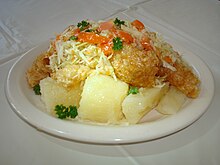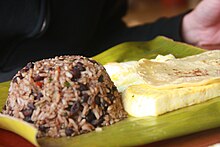Nicaraguan cuisine

| Life in Nicaragua |
|---|
 |
| Art |
| Cinema |
| Cuisine |
| Culture |
| Demographics |
| Education |
| Holidays |
Human Rights
|
| Literature |
| Music |
| Politics |
| Religion |
| Tourism |
Nicaraguan cuisine includes a mixture of
Cuisine
Main staples
As in many other
Commonly used ingredients are peanuts, cabbage (shredded in vinegar, this is called "ensalada" and used as a side dish, sometimes with carrots and beets added), carrots, beets, butternut squash, plantains, bananas, fresh ginger, onion, potato, peppers,
Typical Nicaraguan dishes


- Arroz ancha
- Arroz aguado
- Arroz con pepino
- Arroz con pollo
- Berenjenas rellenas
- Brochetas
- Camarones al ajillo
- Carne asada
- Carne desmenuzada
- Carne enchorizada
- Carne pinchada
- Carne sofrita
- Coctel de conchas
- Corazon asado
- Costillas asadas de cerdo
- Cusuco frito y desmenuzado
- Chancho adobado
- Chancho frito
- Chicharrón con chimichurri
- Churrasco con chimichurri
- Ensalada de aguacate
- Filete en tocineta
- Gallina rellena
- Gallo pinto
- Guacamol Nica
- Guiso de berenjenas
- Guiso de chayote
- Guiso de pipian
- Güirila
- Higado asado
- Higado en caldillo
- Higado frito
- Indio viejo
- Lengua
- Lengua fingida
- Lomo de venado
- Lomo entomatado y encebollado
- Lomo relleno
- Nacatamal
- Pechuga con queso
- Pechuga desmenuzada
- Pescozon
- Pescado a la Tipitapa
- Platanos fritos
- Posta en caldillo
- Punta de Salon henchida
- Quesillo
- Repocheta
- Rondón
- Salpicón
- Sopa de albóndigas
- Sopa de cola
- Sopa de frijoles
- Sopa de gallina con albóndigas
- Sopa de mondongo
- Sopa de pastora
- Sopa de pato
- Sopa de pescado
- Sopa de punche (cangrejo de mar)
- Sopa de queso
- Sopa de res o de hueso
- Sopa de sesos
- Sopa de verduras
- Sopa siete mares
- Substancia de carne o de higado
- Tacos al pastor
- Tajadas con ensalada and/or queso frito
- Tamal pisque
- Tamal relleno
- Tamales
- Tostones
- Vaho
- Venado asado
- Vigorón
Beverages
Refrescos (drinks)

Nicaraguan cuisine makes use of fruits, some of which are only grown in that particular region due to their location. Many fruits are made into drinks known as
Alcoholic beverages
Rums, such as Flor de Caña and Ron Plata (both produced by Compañía Licorera de Nicaragua, S.A (CLNSA)), are both a popularly consumed beverage in Nicaragua and a crucial export product.[9][10]
Popular rum-based cocktails include the "Nica libre," a regional re-naming of the
Beer is also a common alcoholic beverage consumed in Nicaragua. Popular brands include Toña and Victoria, two former competitors both now produced by Compañía Cervecera de Nicaragua, as of a 1996 merger.[attribution needed]
Other drinks
- Achiote con limon
- Achiote con toronja
- Agua de arroz
- Arroz con Pino
- Arroz con piña
- Atol
- Avena (drink)
- Avena con leche
- Avena con limon
- Cacao
- Caimito
- Cebada
- Cebada con limon
- Cebada con Milca
- Coyolito
- Chia
- Chicha
- Chicha bruja
- Chicha de caña
- Chicha de coyol
- Chicha de jocote
- Chocolate
- Ensalada de fruta
- Espinaca (made with spinach berries)
- Fresco de guayabilla
- Guabul
- Granadilla
- Horchata
- Kola Shaler
- Limonada cimarrona
- Linaza
- Linaza con tamarindo
- Mamey (nothing to do with sapodilla)
- Mamón
- Nancite (yellow cherries drink)
- Naranja con remolachas
- Naranja con zanahorias
- Papalon (beach grape drink)
- Papaturro
- Tiste
Postres (desserts)

- Almendras en miel (en jarabe)
- Almibar o curbaza
- Almibar de toncuá
- Arroz con leche
- Atol
- Atol pujagua
- Atolillo
- Ayote en miel
- Bienmesabe
- Botellitas de miel
- Brujas
- Buñuelos de yuca o platano
- Cajeta de ajonjoli
- Cajeta de coco
- Cajeta de coyol
- Cajeta de leche
- Cajeta de piña
- Cajeta de zapoyol
- Cocadas
- Cosa de horno
- Coyol en miel (en jarabe)
- Crispeta
- Cuznaca
- Chiricaya
- Dulce de leche
- Dulce de limon (cidra)
- Dulce de nancite
- Dulce de naranja
- Dulce de piña
- Dulce de papaya
- Dulce de toronja
- Dulce de remolacha con zanahoria
- Enchiclados
- Espumillas
- Gofio
- Flan
- Gofio con anis
- Grosellas en miel (en jarabe)
- Hicacos en miel (en jarabe)
- Jalea de guayaba
- Jalea de mango
- Jalea de patriotas (bananas)
- Jocotes cocidos
- Leche burra
- Maduro asado
- Maduro en gloria
- Maduro horneado
- Mamones en miel (en jarabe)
- Mazapan
- Melcocha
- Motas de atol
- Nancites cocidos
- Nancites en conserva
- Perrerreque
- Piñonate
- Pio Quinto
- Polvorón
- Raspados
- Requeson
- Sopa borracha
- Suspiros
- Toronja en miel (en jarabe)
- Torta de leche
- Tres leches cake
- Turron
See also
References
- ^ Fowler, 1989
- ^ "Chocolate in Mesoamerica A Cultural History of Cacao" (PDF).
- ^ "Costa Rican Archaeology and Mesoamerica" (PDF).
- JSTOR 2569524.
- ^ "Bringing Home the Flavors of Nicaragua: A Provisional Guide to Great Nicaraguan Cuisine".
- ^ "Try the culinary delights of Nicaragua cuisine". Nicaragua.com. Retrieved 2006-05-08.
- ^ "El pinolero y su canción de sangre y esperanza | Maradona | Derechos Humanos. Órgano Informativo de la Comisión de Derechos Humanos del Estado de México" (PDF). Juridicas.unam.mx.
- ^ Ellis, Stefanie. "Fritanga: Welcome to Nicaragua". STLToday. Archived from the original on 2007-11-22. Retrieved 2007-06-07.
- ^ Dara, Jillian (16 October 2019). "Drink Like a Local: Fair Trade Rum from Nicaragua". MICHELIN Guide. Retrieved 2022-09-07.
- ^ Webber, Jude (2015-06-26). "Nicaragua's Flor de Caña rum pays healthy dividends". Financial Times. Archived from the original on 2022-12-11. Retrieved 2022-09-07.
- ISSN 0362-4331. Archived from the originalon 7 September 2022. Retrieved 2022-09-07.
- ^ "Coctel nicaraguense cumple su decimo aniversario". El Nuevo Diario (in Spanish). 22 March 2016. Retrieved 2022-09-07.
- ^ El-Bez, Quentin (2009-02-04). "Découverte - Le Macuà¡, cocktail national du Nicaragua". Alambic Magazine (in French). Retrieved 2022-09-07.
